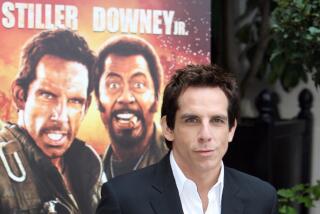Nits and Picks
- Share via
Bill Bryson, the bestselling author who breathed fresh air into the often-tedious genre of nature writing with his hilarious “A Walk in the Woods,” proved that being funny and being grammatically correct are not mutually exclusive. With “Bryson’s Dictionary of Troublesome Words: A Writer’s Guide to Getting It Right,” he seems to be telling us they might be, that writing about writing is very serious business indeed.
Bryson was working in the early 1980s as a copy editor for the London Times when he wrote the first version of “Troublesome Words.” After more years of muddling through difficult questions about grammar and usage, he has revised it with an Americanized flavor.
“Troublesome Words” is a worthwhile addition to any writer’s or editor’s reference library, if only for its common-sense navigation through some of the trickier terrain of the English language. But the eponymous work betrays its limited scope; it is much too thin to stand alone as a definitive guide. Some passages convey the feeling that one is reading the well-scrawled margins of a newspaperman’s stylebook.
“As I observed in the first edition, the book that resulted might more accurately, if less convincingly, have been called ‘A Guide to Everything in English Usage That the Author Wasn’t Entirely Clear About Until Quite Recently,’ ” he writes in the introduction, which isn’t to say that he has yet found all the answers.
It is that self-effacing banter that is missing in the alphabetized entries that follow and, from this clever and skilled writer, it feels like a missed opportunity. Any writing guide published today must compete with the work of the prescriptive linguist Bryan A. Garner, whose “A Dictionary of Modern American Usage” (1998) set a new standard by offering an accessible, comprehensive, pragmatic guide to using the English language.
Garner provides more than 750 pages of do’s and don’ts, with a minimum of maybes, those betes noires of serious writers and editors everywhere. It is an indispensable guide for anyone who wants to write more clearly but prefers his medicine without the schoolmarmish tone dispensed by some of the giants of modern usage.
Bryson chose not to write “Troublesome Words” as a rival to Garner or to the revered, if sometimes quirky, language texts of H.W. Fowler (“A Dictionary of Modern English Usage,” 1926; revised by Ernest Gowers, 1965, and Robert Burchfield, 1996) or those of Theodore Bernstein (“The Careful Writer,” 1965) and John Bremner (“Words on Words,” 1980). Bryson’s admonition in the introduction that “[w]hat follows should be regarded less as a book of instruction than as a compilation of suggestions, observations, and even treasured prejudices” makes that clear. Bryson keeps the pedantry to a minimum, but “Troublesome Words,” part stylebook, part dictionary, part usage guide, never delivers fully in any of these areas.
Unfortunately, he didn’t take the approach of Bill Walsh of the Washington Post, whose wry “Lapsing Into a Comma: A Curmudgeon’s Guide to the Many Things That Can Go Wrong in Print--and How to Avoid Them” (2000) is a useful if truncated language guide that doesn’t take itself too seriously, even if it considers good writing a serious topic.
“Troublesome Words” could use a snigger here and there to remind us that it’s one man’s vision and that things get blurry from time to time. None of this is to suggest that Bryson is a dabbler. He is a well-regarded writer on a number of topics who, like Garner, has a refreshingly common-sense approach.
Bryson is a serious student of the language, ranting against the overuse of the redundant “new” (as in “new record”), offering a measured approach on “none” (it can take a plural or singular verb, as long as the writer is consistent) and insisting that “bacteria” be used as a plural noun. He lobbies for cutting the fat (the pre-in “precondition,” “preregister” and the like is unnecessary), roping in the dangling modifier and accepting that “irregardless” is not, and ought never be, a word.
Although he acknowledges that language evolves, Bryson is mostly a linguistic conservative like Garner. He doesn’t subscribe to the descriptive school that allows for the wholesale butchering of the written word as the inevitable outcome of our lax standards in oral communication. Descriptivists believe that if people say it, we should accept its being written, even if it means turning our backs on the basics of good grammar.
Although he will not cave to the forces of substandard English on the differences between “comprise” and “compose,” he gives in to the descriptivists when he refuses to stand his ground on the oft-misused “begging the question,” reasoning that its definition as a circular argument in logic has been lost to those who need a fancier way to say somebody invited or raised a question.
Bryson rightly preaches against the misuse of “enormity” to indicate something large (it may be large, but it also must be outrageous or wicked) yet is willing to allow “loan” and “lend” to be used interchangeably, even though most serious grammarians insist on the use of “loan” only as a noun.
He offers wise counsel on the numbing effects of repeating acronyms, the confusing results of piling adjective upon adjective and the reckless misuse of percents. (A tax reform bill that cuts the top rate from 50% to 25% cuts the rate by half, not 25% as a newspaper headline announced.) He offers helpful explanations of “tortuous/torturous” and myriad other misusages that regularly stump us all.
“Affect/effect,” “it’s/its,” “amid/among”? The proper use of “crescendo”? They’re here. But he lists “hark” and “hearken” as if for spelling purposes only, failing to explain the difference between them and how each is to be used. (They both mean to listen carefully, but when one wants to indicate the return to another point or time, “hark back” is preferred.)
Although Bryson prohibits the redundant “totally destroyed,” he incongruously argues for “partly destroyed,” reasoning that there “is simply no other way of putting it without resorting to more circuitous descriptions.” (“Damaged” is an alternative that newspaper reporters and editors find works well.)
There is a bit of everything here, including some trivia only a copy editor could love: Hans Christian Andersen (not -son); the Uffizi Gallery in Florence; Sir Thomas Malory (one l); hartebeest (not -beast) for the African antelope.
An entry on the misuse of “bemused” or a primer on sequence of tenses would have been a better use of space. But that is the flaw in most such works; they cannot possibly be comprehensive, for each of us has his or her own set of nits and picks.
“Troublesome Words” is an accessible guide, worth picking up for its measured approach to the myth of never splitting an infinitive. Or if only to confirm that Nullarbor Plain is correctly spelled with two Rs and is in Western Australia.
More to Read
Sign up for our Book Club newsletter
Get the latest news, events and more from the Los Angeles Times Book Club, and help us get L.A. reading and talking.
You may occasionally receive promotional content from the Los Angeles Times.







